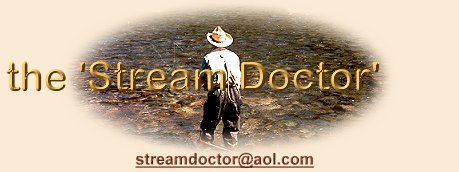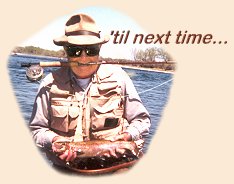
| ||
|
March 7th, 2005
|
|
Q. Is it possible that stocked trout deplete the level of insect life necessary to sustain native trout? We have a heavily stocked stream with some feisty natives but very little insect activity. Bob Harvey
A.
This question isn't quite as easy to answer as it might appear. The
short answer to your question is that the low populations of insects in your
stream could be because of increased trout predation – but, it could also be
related to a small food base for the insects. Ecologists refer to these two
situations as "top down" and "bottom up" control. If you'll bear with me,
I'll explain and see how it might fit your situation.
You are essentially dealing with three feeding levels in the food web; the
predatory trout, the omnivorous insects, and the food base of the insects (algae
growing on the rocks and detritus); all are competing for resources (food,
space, etc.). In the usual situation, the rule of thumb is that it takes about
10 times as much biomass at one level to support the next level. Roughly, 100
grams of algae would support 10 grams of insects that would support 1 gram of
trout biomass; each food level will support only a certain amount of biomass
that feeds on it. (There's an interesting story called "Allen's Paradox"
concerning brown trout and insects in the Horokiwi Stream in New Zealand that
has fascinated ecologists for years – but that's another story). Now let's see
how this situation might change if conditions at one level change, and please
realize that I'm using a pretty simplistic situation.
Stocking more trout would result in increased predation on the insects and a
lowering of their population. This would continue until the 10:1 ratio again
became established, either from fewer trout or more insects. A decreased
insect population would result in a lessened impact on the algal community, with a
resulting increase in algal biomass. Increasing algal biomass would provide
food for more insects. However, the insects cannot take immediate advantage
of the increased algal food base because they must go through an entire life
cycle (taking months to years to complete), so you don't see an immediate
increase in their numbers. Once new generations hatch, the increased food base can
support more insects until the 100:10:1 ratio again becomes established. This
is an example of "top down" control.
However, if a decrease in the insect population did not result in a
proliferation of algal growth, it probably indicates that some other factor is limiting
the growth of algae; this could be low nutrients, shading, unsuitable
substrate, or some other ecological factor. In this case, the limits on the insect,
and hence the trout, population are because of an inadequate food supply; this
is "bottom up" control.
Unfortunately, we do not know what the insect population in your stream was
like prior to introduction of the stocked trout. If insects were more
numerous, then it is likely that the trout are exerting "top down" control and you
should see more algae on the bottom than before; again, we don't know. If,
however, the insect population was always low, then their numbers might be "bottom
controlled" with additional pressure from the trout.
There are some other factors that enter into your situation that may or may
not play significantly. The stocked trout will increase the impact on the
insect community, depending upon how many stocked fish there are relative to the
native population, and upon their aggressiveness. If the stocked trout are
relatively low in number as compared to the natives, they will probably have
little overall impact. Further, most stocked populations are less aggressive than
natives because they are used to being fed and take awhile to learn that they
are on their own and must find and compete for a strange and different food
base. Another factor depends on the angling situation; if it is a heavily
fished stream, the stockers usually don't remain long enough to have a significant
impact; they are caught and removed quickly, unless it is a catch-and-release
situation where they may not be removed. Nevertheless, most stocked fish
don't survive as well as the natives. Montana stopped stocking streams years ago
when they discovered that it didn't help fishing at all; in fact it hurt it.
This, however, may not be feasible everywhere.
Well, this is probably more than you wanted, but I hope it is of interest.
If you have further questions, let me know.
If you have a question, please feel free to contact me.
|
| If you would like to comment on this or any other article please feel free to post your views on the FAOL Bulletin Board! |
 The 'Stream Doctor' is a retired professional stream ecologist and
author, now living in the West and spending way too much time
fly-fishing. You are invited to submit questions relating to
anything stream related directly to him for use in this Q & A Feature
at
The 'Stream Doctor' is a retired professional stream ecologist and
author, now living in the West and spending way too much time
fly-fishing. You are invited to submit questions relating to
anything stream related directly to him for use in this Q & A Feature
at